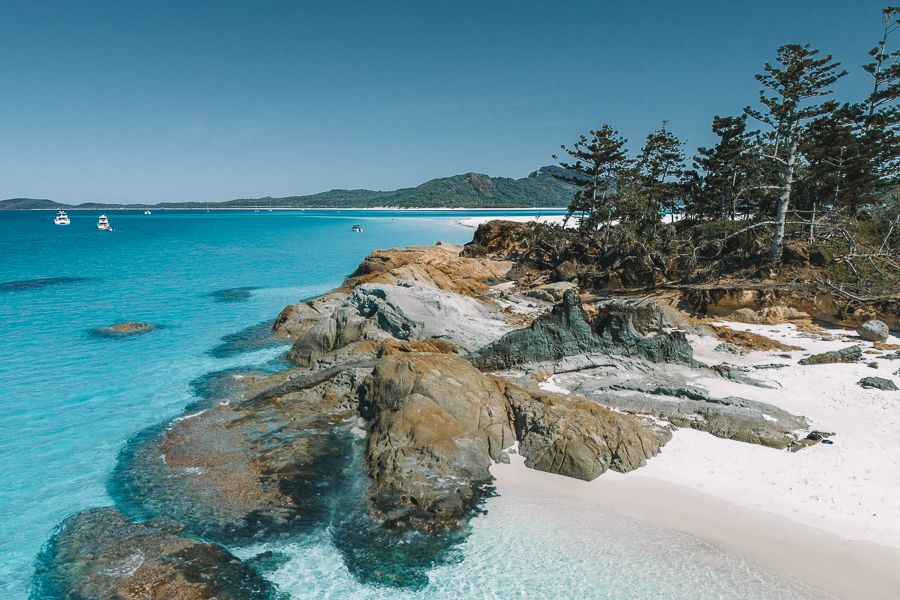A Short History Of The Whitsundays
Ever wondered how the Whitsundays came to be? This stunning collection of islands in Tropical North Queensland, Australia, has a fascinating history! Here is our quick overview of the history of the Whitsundays. Hopefully visitors can appreciate how magnificent these tropical islands and reefs really are!

A Brief History of the Whitsundays
There are many facets to the history of the Whitsundays. We'll split our account into sections so you can wrap your head around the vast history and formation of the islands. It's been quite a journey to the glorious, tourist hotspot that the Whitsundays are today!

Formation of the Whitsunday Islands
The formation and development of the islands was a long, ancient journey. Over 100 million years ago, the land of the Whitsundays was born of violent volcanoes and a shift in the Earth’s crust. The movement underneath the Earth's surface caused land to rise upwards, forming mountains.
Then, during the last ice age 1000 years ago, the region began to flood. The flow of water filled the valleys, leaving behind only the tips of the earlier mountains. These mountain tops are what we know to be the Whitsunday Islands. Meanwhile, the Great Barrier Reef is forming right offshore due to the movement of sand and currents in the ocean!

The first human inhabitants in the Whitsundays
No one truly knows when the first people came to the Whitsundays, but it is certain that they have lived in this area for at least 9,000 years and for as many as 45,000 years.
The Whitsunday area’s original inhabitants, the Ngaro, Juru, Gia, and Biria Indigenous Australians, lived throughout the Whitsundays. People lived within their own territories and maintained individual tribes. The tribes were spread from Mackay to Bowen on the mainland, with the Ngaro People inhabiting the Whitsunday Islands.
The Ngaro were the principal owners of the islands and roamed from Cape Conway onwards to the mountains of Proserpine. They were largely nomadic between the islands themselves and the land, dependent on what the lands or seas could provide.
Remnants of the Ngaro People in the Whitsundays
Because of the constant change in the tides, rising of the ocean and cultural erasure, many traces of Australia’s original inhabitants have long since disappeared. However, the history of the Ngaro peoples can be found at Nara Inlet's Ngaro Cultural Site, with ancient cave paintings and signs of Indigenous populations visible today.

Arrival of the Europeans
The islands were in the care of the Indigenous populations for many thousands of years until the arrival of European invaders in 1770. This marked a major shift in Australia's history, with tragic outcomes such as genocide, colonisation and oppression of the native people.
Although Cook claimed the land for England in 1770 it wasn't until almost 100 years later, in 1860, those white settlers began to settle in the area. Relatively quickly and very violently, the newcomers drove the First Nations people out of the area and off the islands, settling it for timber farms, grazing grounds and permanent homes, with many Indigenous people being killed, enslaved or indentured. It's one of the many heartbreaking stories around Australia.
Where did the name Whitsundays come from?
The Whitsundays were claimed by Captain James Cook in 1770 on the 7th Sunday after Easter on “Whitsun,” giving way to their colonial name and the influence of the modern world.

Tourism in the Whitsundays
Tourism didn’t grasp the Whitsundays until the 1920s. The first resort came to Lindeman Island in 1929, and by this time the original inhabitants were all but extinct in the Whitsundays. By the 1930s the land was largely populated by the white newcomers, tourists and visitors, with only a few First Nations people left, who were usually employed by resorts and the tourism industry, owned by white immigrants.

The Whitsunday Islands today
The once secluded and untouched area that is the Whitsundays now has 7 islands that are home to resorts, with millions of visitors yearly. There are 6 national parks spanning over 70 of the 74 Whitsunday Islands, protecting the islands and their marine life. With the Great Barrier Reef Marine Park right on the coast of the islands as well, the underwater world is protected.
Some islands have modern resorts and facilities, such as Hamilton Island, Daydream Island, Long Island, and Hayman Island. Guests can explore the area on boat tours, reef pontoons, private charters, or scenic flights. There are so many opportunities for adventure, and luckily most local tour operators understand the importance of protecting and respecting the natural environment in the Whitsundays!
Explore the Whitsundays with these tours and activities!

Respecting the Whitsundays
Although very different from how it looked 150 years ago, the beauty and resilience of the islands continue to persevere. Iconic places like Whitehaven Beach are still completely uninhabited, with only a few facilities and structures there for humans. And many islands in the Whitsundays are 100% uninhabited.
So visit the Whitsundays and enjoy its natural delights. But always respect the environment! Avoid littering, disturbing wildlife, or altering the landscape in any way. Stay on marked trails, read informational signs, and leave any area just as pristine as it was when you arrived.
It is up to us to help maintain the beauty of the Whitsundays, allowing it to flourish and remain healthy by respecting the land and its wildlife!













